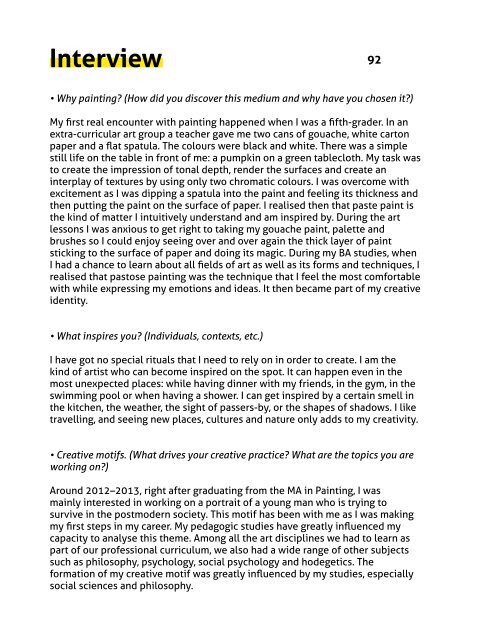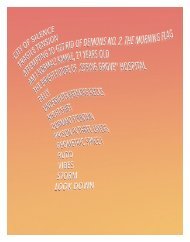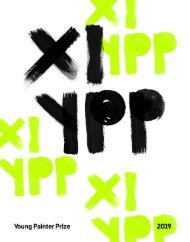X YPP Book
The main aim of the project - to discover new talent in Baltic States.
The main aim of the project - to discover new talent in Baltic States.
Create successful ePaper yourself
Turn your PDF publications into a flip-book with our unique Google optimized e-Paper software.
Interview 92<br />
• Why painting? (How did you discover this medium and why have you chosen it?)<br />
My first real encounter with painting happened when I was a fifth-grader. In an<br />
extra-curricular art group a teacher gave me two cans of gouache, white carton<br />
paper and a flat spatula. The colours were black and white. There was a simple<br />
still life on the table in front of me: a pumpkin on a green tablecloth. My task was<br />
to create the impression of tonal depth, render the surfaces and create an<br />
interplay of textures by using only two chromatic colours. I was overcome with<br />
excitement as I was dipping a spatula into the paint and feeling its thickness and<br />
then putting the paint on the surface of paper. I realised then that paste paint is<br />
the kind of matter I intuitively understand and am inspired by. During the art<br />
lessons I was anxious to get right to taking my gouache paint, palette and<br />
brushes so I could enjoy seeing over and over again the thick layer of paint<br />
sticking to the surface of paper and doing its magic. During my BA studies, when<br />
I had a chance to learn about all fields of art as well as its forms and techniques, I<br />
realised that pastose painting was the technique that I feel the most comfortable<br />
with while expressing my emotions and ideas. It then became part of my creative<br />
identity.<br />
• What inspires you? (Individuals, contexts, etc.)<br />
I have got no special rituals that I need to rely on in order to create. I am the<br />
kind of artist who can become inspired on the spot. It can happen even in the<br />
most unexpected places: while having dinner with my friends, in the gym, in the<br />
swimming pool or when having a shower. I can get inspired by a certain smell in<br />
the kitchen, the weather, the sight of passers-by, or the shapes of shadows. I like<br />
travelling, and seeing new places, cultures and nature only adds to my creativity.<br />
• Creative motifs. (What drives your creative practice? What are the topics you are<br />
working on?)<br />
Around 2012–2013, right after graduating from the MA in Painting, I was<br />
mainly interested in working on a portrait of a young man who is trying to<br />
survive in the postmodern society. This motif has been with me as I was making<br />
my first steps in my career. My pedagogic studies have greatly influenced my<br />
capacity to analyse this theme. Among all the art disciplines we had to learn as<br />
part of our professional curriculum, we also had a wide range of other subjects<br />
such as philosophy, psychology, social psychology and hodegetics. The<br />
formation of my creative motif was greatly influenced by my studies, especially<br />
social sciences and philosophy.<br />
Why am I interested in portraying a young man? I hear this question often. Why<br />
not an old man? I considered youth as being more vulnerable, and I was drawing<br />
on my own self-analysis. How do I see myself in this society, and how does is it<br />
making me feel? What do my friends think about these questions, and what are<br />
their experiences? The existential problematics of a young man was particularly<br />
interesting to me. I remember doubting a lot regarding my chosen path. I feared<br />
I was going too deep with this, and that the problems I was working on were not<br />
relevant and understandable. I feared being ridiculed. I was even considering<br />
choosing a topic that was more accessible and popular. After all, everyone is<br />
chasing fashionable things and aiming to get to the top of popularity. Perhaps I<br />
was supposed to follow the opinions of art critics and copy what was exhibited<br />
in the contemporary art galleries, because art is business — you have to paint<br />
things that other would want to buy. However I decided not to go down this path.<br />
I like taking risks and I do only what I am truly interested in and what I find relevant.<br />
After receiving the <strong>YPP</strong> Award I realised that I have to keep doing what is<br />
important to me, and not the kind of art that my teachers, my parents, art critics<br />
or gallerists prefer. One should not be afraid of this attitude. There will always<br />
be people who will understand and help you. When I started living in emigration,<br />
Lithuania-related motifs started receding. When the environment, culture,<br />
lifestyle, and social context changed, I began working on smaller and more<br />
manageable projects.<br />
• What can you tell us about your creative process? Where does your artwork start<br />
and where does it end?<br />
Naturally, everything starts in with contemplating an idea, a motive, an object, a<br />
form, tonal depth and composition, and then, after the visualisations and<br />
sketches are made, I commit to painting. The painting is often influenced by the<br />
scale, and I have to change both composition and tonal arrangement. Colours and<br />
compositional elements have various impacts depending on the size of a canvas.<br />
I am paying a lot of attention to my palette. I think even the grayest of minds can<br />
produce a wide variety of tones. Which is why, I think, it is very important to<br />
carefully arrange a palette before I start. It takes time to create an artwork, and I<br />
let them appear gradually. I use the multiple layering technique, which means I<br />
have to work in stages. I see the whole process as a creation of the series of<br />
layers. It is important to understand how layering will influence the opaqueness<br />
and the distribution of tones and shades, how will they look in a month or even<br />
in a year, and what chemical processes might start taking place. When I put thin<br />
layers of paint on top of each other, I imagine that I am using the layers of<br />
coloured glass — the overlaying colours are able to create subtle tonal effects<br />
and depths. I often leave a half-finished painting hanging on the wall. I like<br />
seeing them greeting me as I walk into the studio. I can spend hours<br />
contemplating them and thinking about various tonal combinations. The creation<br />
of a single painting can last up to several months. Finalising is usually difficult<br />
because it always seems that there’s something else I can add. Thus it is<br />
important to learn how to stop.





